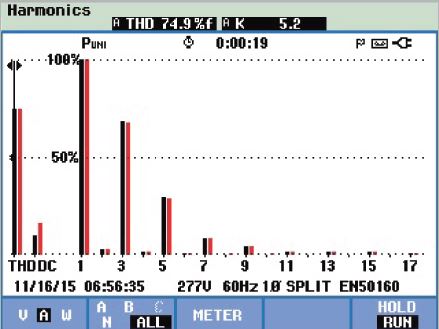Low Harmonics
Keeping electrical harmonics in check can help your power utility by allowing for smaller transformers and preventing possible down-the-line issues. More importantly, it can lower your utility bill, increase your power reliability, and lower your equipment maintenance costs. If you aren't familiar with electrical harmonics and the IEEE 519 standard, you may not be able to ignore it for much longer. Utilities across the country are beginning to mandate compliance.
Phase Technologies’ LH Series drives use an active switching input module to limit harmonic distortion of the input current, therefore limiting voltage harmonics on the power system. If you need an IEEE 519 friendly variable frequency drive (VFD), we can help.
What Are Harmonics?
In electrical systems, harmonics are distortions in current and voltage waveforms. The distortions are mathematically described by voltages and currents at frequencies other than the fundamental frequency of 60 Hz.
What Causes Harmonics?
In electrical systems, harmonics are created by non-linear loads from switching power supplies, VFDs, solid state heater controls, transformers, rectifiers, and other saturated magnetic devices. Often distortions in current produce distorted voltages when the transformers become saturated and the system cannot effectively source the large current surges drawn by the non-linear loads.
Harmonic Profiles Comparison

THD Current = 3.1%
Single-phase harmonics comparison
A comparison of the harmonic distortion on the input of a Phase Technologies 1LH series VFD (left) compared to a standard single-phase input diode bridge variable frequency drive with DC link choke (right).

THD Current = 74.9%

THD Current = 5.4%
Three-phase harmonics comparison
A comparison of the harmonic distortion on the input of a Phase Technologies 3LH series VFD (left) compared to a standard three-phase input diode bridge variable frequency drive with DC link choke (right).

THD Current = 46%
Total Harmonic Distortion (THD) of LH Series Drives vs. Standard Diode Bridge Drives
In these tests harmonic distortion was reduced by 90-95%.
The Impact Of Harmonics?
Harmonic distortion generated by standard VFD's creates problems for the power utility and other customers on the electrical distribution system. Problems include overheating of distribution transformers due to saturation, overheating of conductors, failure of sensitive equipment, and an overall degradation of power quality. High voltage transients and voltage unbalance are byproducts of harmonics. Motors can be damaged when the high voltage transients break down winding insulation. Unbalanced voltages increase motor running temperatures and can produce damaging arcing inside shaft bearings.
What Is IEEE 519 Compliance?
IEEE 519-2014 is an industry standard that determines allowable limits of voltage and current distortion on utility systems. As the use of VFDs has increased, so have the negative impacts of the harmonics they generate. As a result, more utilities are enforcing compliance with IEEE 519. 1LH and 3LH series drives will meet this stringent specification without the use of any additional external harmonic filtering.
Our Guarantee
Phase Technologies guarantees that LH product lines will meet the IEEE 519-2014 standard when
at least 80% of rated current load is maintained. If a system does not comply, Phase Technologies
will either offer a suitable fix to bring the panel into compliance or offer a full refund for
the purchase price of the panel upon return.
(See product warranty for details)